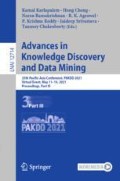Abstract
The greater public has become aware of the rising prevalence of untrustworthy information in online media. Extensive adaptive detection methods have been proposed for mitigating the adverse effect of fake news. Computational methods for detecting fake news based on the news content have several limitations, such as: 1) Encoding semantics from original texts is limited to the structure of the language in the text, making both bag-of-words and embedding-based features deceptive in the representation of a fake news, and 2) Explainable methods often neglect relational contexts in fake news detection. In this paper, we design a knowledge graph enhanced framework for effectively detecting fake news while providing relational explanation. We first build a credential-based multi-relation knowledge graph by extracting entity relation tuples from our training data and then apply a compositional graph convolutional network to learn the node and relation embeddings accordingly. The pre-trained graph embeddings are then incorporated into a graph convolutional network for fake news detection. Through extensive experiments on three real-world datasets, we demonstrate the proposed knowledge graph enhanced framework has significant improvement in terms of fake news detection as well as structured explainability.
Access this chapter
Tax calculation will be finalised at checkout
Purchases are for personal use only
References
Angeli, G., Johnson Premkumar, M.J., Manning, C.D.: Leveraging linguistic structure for open domain information extraction. In: ACL, pp. 344–354, July 2015
Bordes, A., Usunier, N., Garcia-Duran, A., Weston, J., Yakhnenko, O.: Translating embeddings for modeling multi-relational data. In: NeurIPS, pp. 2787–2795 (2013)
Cho, K., et al.: Learning phrase representations using RNN encoder-decoder for statistical machine translation. In: EMNLP, pp. 1724–1734, October 2014
Ciampaglia, G.L., Shiralkar, P., Rocha, L.M., Bollen, J., Menczer, F., Flammini, A.: Computational fact checking from knowledge networks. PLoS ONE 10(6), 1–13 (2015)
Deng, S., Rangwala, H., Ning, Y.: Learning dynamic context graphs for predicting social events. In: KDD 2019, pp. 1007–1016. ACM, New York (2019)
Dettmers, T., Minervini, P., Stenetorp, P., Riedel, S.: Convolutional 2d knowledge graph embeddings. In: Proceedings of the 32th AAAI Conference on Artificial Intelligence, pp. 1811–1818. AAAI (2018)
Grinberg, N., Joseph, K., Friedland, L., Swire-Thompson, B., Lazer, D.: Fake news on twitter during the 2016 U.S. presidential election. Science 363(6425), 374–378 (2019)
Hochreiter, S., Schmidhuber, J.: Long short-term memory. Neural Comput. 9(8), 1735–1780 (1997)
Karimi, H., Tang, J.: Learning hierarchical discourse-level structure for fake news detection. In: NAACL-HLT, pp. 3432–3442, June 2019
Kim, Y.: Convolutional neural networks for sentence classification. In: EMNLP, pp. 1746–1751, October 2014
Kipf, T.N., Welling, M.: Semi-supervised classification with graph convolutional networks. In: ICLR (2017)
Lazer, D.M.J., et al.: The science of fake news. Science 359(6380), 1094–1096 (2018)
Levi, O., Hosseini, P., Diab, M., Broniatowski, D.: Identifying nuances in fake news vs. satire: using semantic and linguistic cues. In: Proceedings of the Second Workshop on Natural Language Processing for Internet Freedom: Censorship, Disinformation, and Propaganda, pp. 31–35, November 2019
Lu, Y.-J., Li, C.-T.: GCAN: graph-aware co-attention networks for explainable fake news detection on social media (2020)
Magdy, A., Wanas, N.: Web-based statistical fact checking of textual documents. SMUC 2010, 103–110 (2010)
Nguyen, D.M., Do, T.H., Calderbank, R., Deligiannis, N.: Fake news detection using deep Markov random fields. ACL-HLT 2019, 1391–1400 (2019)
Nickel, M., Rosasco, L., Poggio, T.: Holographic embeddings of knowledge graphs. AAAI 2016, 1955–1961 (2016)
Pan, J.Z., Pavlova, S., Li, C., Li, N., Li, Y., Liu, J.: Content Based Fake News Detection Using Knowledge Graphs. In: Vrandečić, D., Bontcheva, K., Suárez-Figueroa, M.C., Presutti, V., Celino, I., Sabou, M., Kaffee, L.-A., Simperl, E. (eds.) ISWC 2018. LNCS, vol. 11136, pp. 669–683. Springer, Cham (2018). https://doi.org/10.1007/978-3-030-00671-6_39
Pérez-Rosas, V., Kleinberg, B., Lefevre, A., Mihalcea, R.: Automatic detection of fake news. In: COLING, vol. 18, pp. 3391–3401 (2018)
Rubin, V., Conroy, N., Chen, Y.: Towards news verification: Deception detection methods for news discourse, January 2015
Shi, B., Weninger, T.: Fact checking in heterogeneous information networks. In: WWW 2016 Companion, pp. 101–102 (2016)
Shu, K., Cui, L., Wang, S., Lee, D., Liu, H.: dEFEND: explainable fake news detection. In: KDD 2019, pp. 395–405 (2019)
Shu, K., Mahudeswaran, D., Wang, S., Lee, D., Liu, H.: FakeNewsNet: a data repository with news content, social context and spatialtemporal information for studying fake news on social media (2018)
Shu, K., Sliva, A., Wang, S., Tang, J., Liu, H.: Fake news detection on social media: a data mining perspective. SIGKDD Explor. Newsl. 19(1), 22–36 (2017)
Vashishth, S., Sanyal, S., Nitin, V., Talukdar, P.: Composition-based multi-relational graph convolutional networks. In: ICLR (2020)
Wang, Q., Mao, Z., Wang, B., Guo, L.: Knowledge graph embedding: a survey of approaches and applications. IEEE Trans. Knowl. Data Eng. 29(12), 2724–2743 (2017)
Wang, Y., Ma, F., Jin, Z., Yuan, Y., Xun, G., Jha, K., Su, L., Gao, J.: EANN: event adversarial neural networks for multi-modal fake news detection. KDD 18, 849–857 (2018)
Wu, Y., Agarwal, P.K., Li, C., Yang, J., Yu, C.: Toward computational fact-checking. Proc. VLDB Endow. 7(7), 589–600 (2014)
Yang, B., tau Yih, W., He, X., Gao, J., Deng, L.: Embedding entities and relations for learning and inference in knowledge bases. CoRR, abs/1412.6575 (2015)
Zhang, Z., Han, X., Liu, Z., Jiang, X., Sun, M., Liu, Q.: ERNIE: enhanced language representation with informative entities. In: ACL (2019)
Zhou, X., Zafarani, R.: Fake news: a survey of research, detection methods, and opportunities. ArXiv, abs/1812.00315 (2018)
Acknowledgements
This work is supported in part by the US National Science Foundation under grants 1948432, 1763620 and 1948374.
Author information
Authors and Affiliations
Corresponding author
Editor information
Editors and Affiliations
Rights and permissions
Copyright information
© 2021 Springer Nature Switzerland AG
About this paper
Cite this paper
Wu, K., Yuan, X., Ning, Y. (2021). Incorporating Relational Knowledge in Explainable Fake News Detection. In: Karlapalem, K., et al. Advances in Knowledge Discovery and Data Mining. PAKDD 2021. Lecture Notes in Computer Science(), vol 12714. Springer, Cham. https://doi.org/10.1007/978-3-030-75768-7_32
Download citation
DOI: https://doi.org/10.1007/978-3-030-75768-7_32
Published:
Publisher Name: Springer, Cham
Print ISBN: 978-3-030-75767-0
Online ISBN: 978-3-030-75768-7
eBook Packages: Computer ScienceComputer Science (R0)

